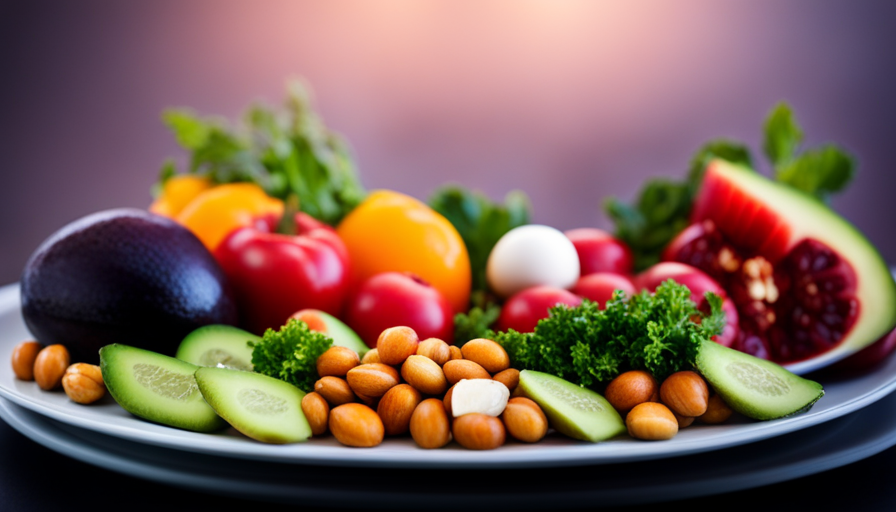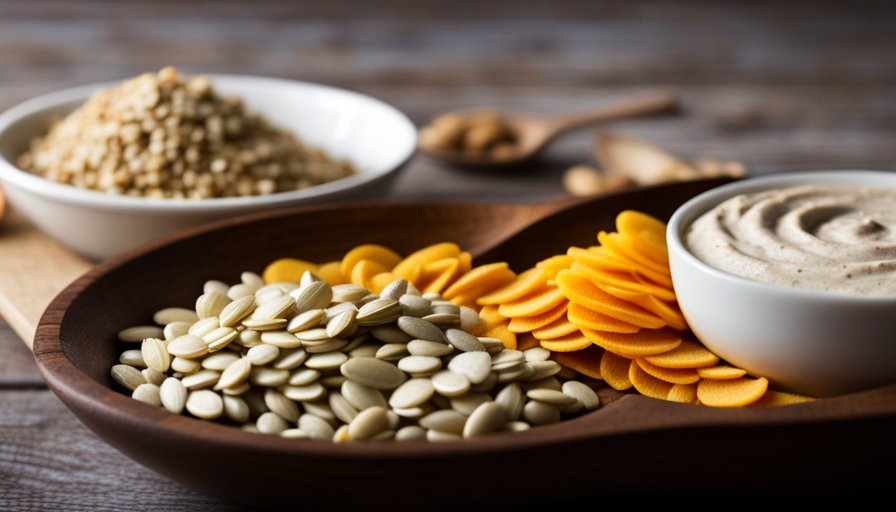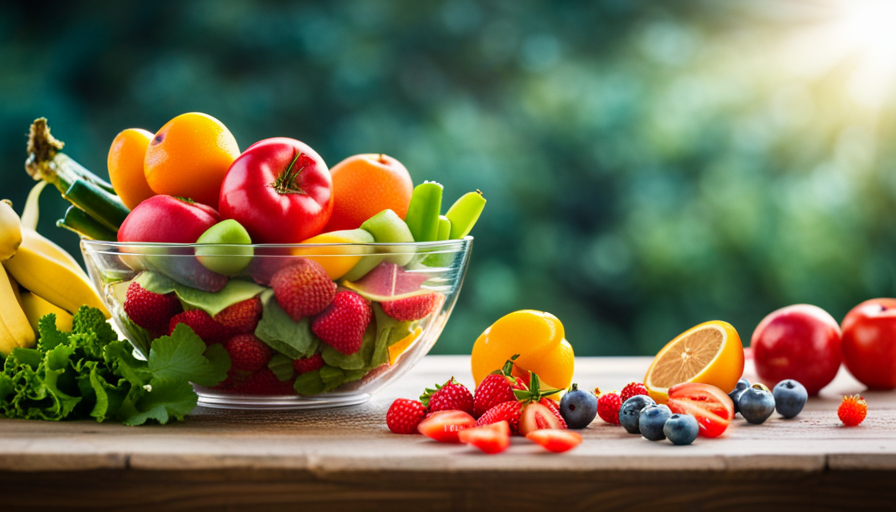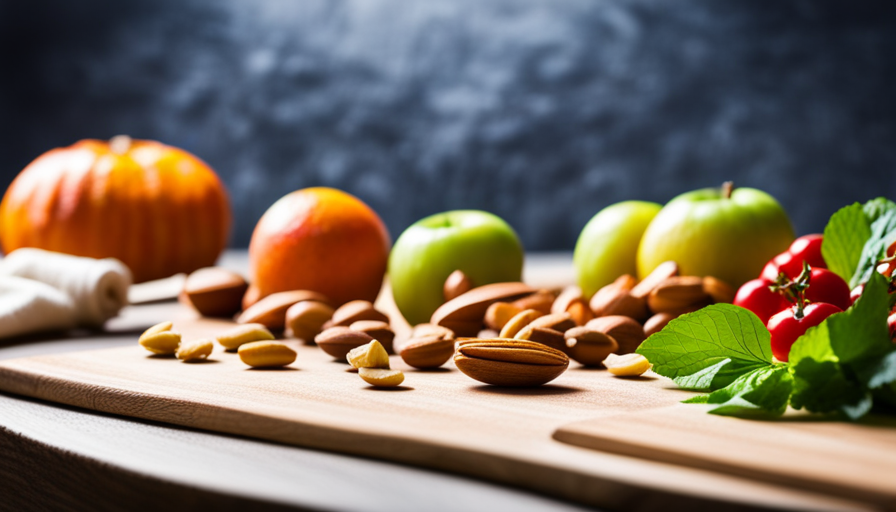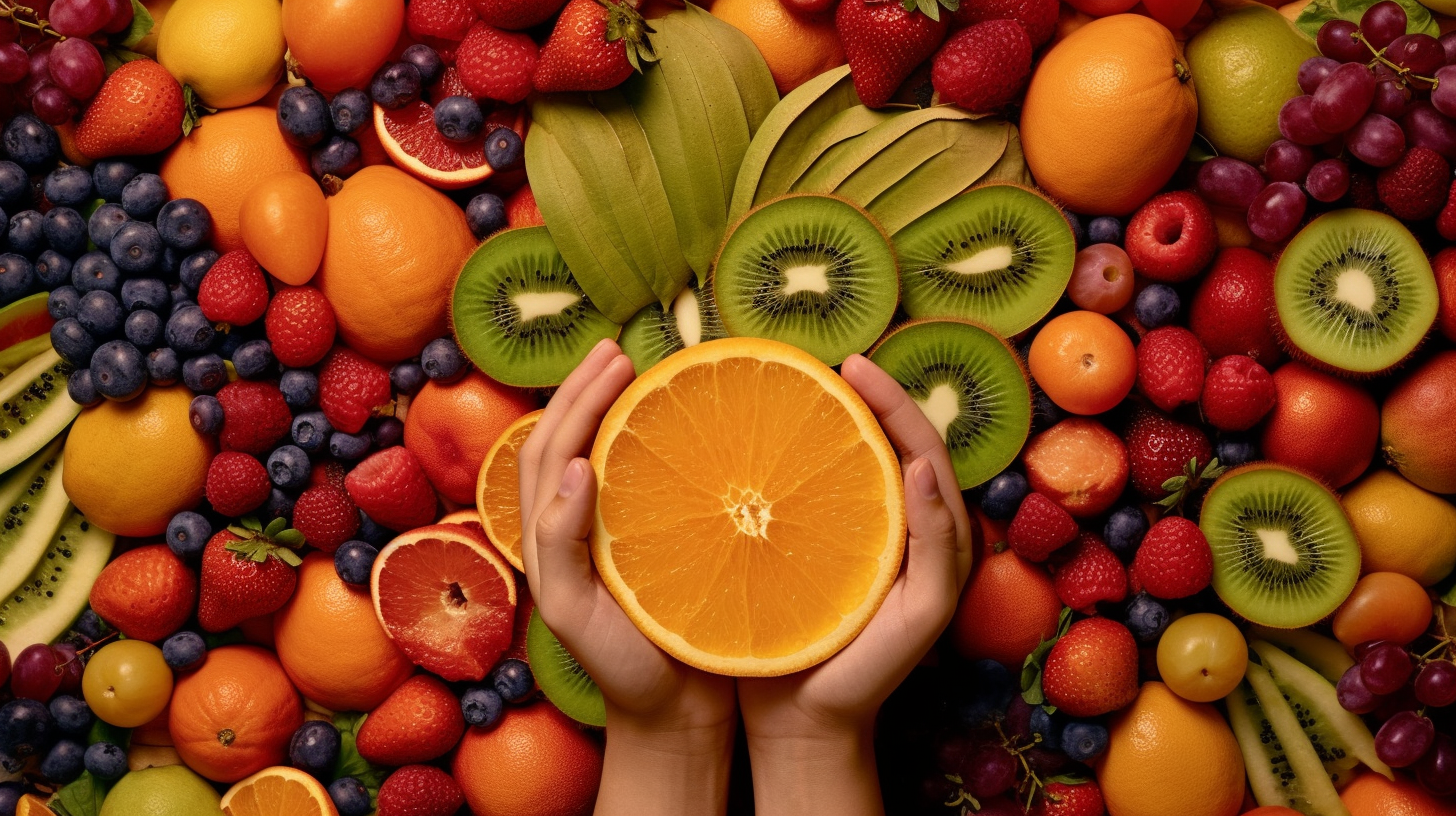Are you striving to improve your overall health and reach your weight loss goals? With so many diet options out there, it can be difficult to choose the right one for you. Have you thought about comparing the keto diet to the raw food diet? Both of these dietary approaches have become increasingly popular, but which one is better for your overall well-being?
In this article, we will explore the keto diet and the raw food diet, examining their principles, potential health benefits, and drawbacks. By understanding the science behind these diets, you can make an informed decision that suits your lifestyle and goals.
So, are you ready to dive into the world of diets and discover which one is best for you? Let’s get started!
Key Takeaways
- The keto diet focuses on high fat, moderate protein, and low carbohydrate intake, aiming to put the body into a state of ketosis. It can lead to weight loss, improve insulin sensitivity, and may have neurological benefits.
- The raw food diet emphasizes consuming unprocessed and uncooked foods like fruits, vegetables, nuts, seeds, and sprouts. It retains more nutrients and enzymes compared to cooking, increases fiber intake, and can aid in weight loss.
- Both diets have their advantages and disadvantages. The keto diet may reduce the risk of heart disease and can be effective for short-term weight loss, but may lead to nutrient deficiencies and constipation. The raw food diet provides abundant nutrients and supports overall health, but may be harder to digest and carry a higher risk of foodborne illnesses.
- It is important to consider individual dietary needs and goals when choosing a diet. Consulting with a healthcare professional or registered dietitian is recommended before making any dietary changes.
Understanding the Keto Diet
Get ready to dive into the world of the Keto diet and discover its incredible benefits! When comparing the Keto diet to the Paleo diet, it’s important to note that both have their own unique approaches to nutrition.
The Keto diet, short for ketogenic, focuses on high fat, moderate protein, and low carbohydrate intake. This approach aims to put your body into a state of ketosis, where it uses fat as its primary source of fuel instead of carbohydrates.
One of the main benefits of the ketogenic diet is weight loss. By drastically reducing carbohydrate intake, your body starts burning fat for energy, resulting in weight loss. Additionally, the Keto diet has been shown to improve insulin sensitivity and stabilize blood sugar levels, making it beneficial for individuals with diabetes or insulin resistance.
Moreover, the Keto diet may have neurological benefits. Studies have suggested that it can help reduce seizures in individuals with epilepsy. It may also improve cognitive function and provide neuroprotective effects.
However, it’s important to note that the Keto diet may not be suitable for everyone. It requires careful planning and monitoring to ensure adequate nutrient intake. Additionally, some individuals may experience side effects such as the ‘keto flu’ during the initial transition period.
The Keto diet offers numerous benefits, including weight loss, improved insulin sensitivity, and potential neurological benefits. However, it’s important to consult with a healthcare professional before starting any new diet to ensure it aligns with your individual needs and goals.
Exploring the Raw Food Diet
Delving into the world of the Raw Food Diet unveils a fascinating approach to nourishing the body. This diet emphasizes consuming unprocessed and uncooked foods, such as fruits, vegetables, nuts, seeds, and sprouts. Here are some key points to consider:
-
Advantages of the Raw Food Diet:
- Nutrient-rich: Raw foods retain more vitamins, minerals, and enzymes that can be lost through cooking.
- Increased fiber intake: Raw fruits and vegetables are high in fiber, which aids in digestion and helps maintain a healthy weight.
- No additives or preservatives: By avoiding processed foods, you eliminate potentially harmful additives and preservatives.
-
Challenges of the Raw Food Diet:
- Cooking techniques: The Raw Food Diet requires specific cooking techniques like juicing, blending, dehydrating, or sprouting, which may require additional equipment and time.
- Meal planning: Planning meals on the Raw Food Diet can be challenging, as it involves sourcing fresh, organic produce and ensuring a balance of nutrients.
While the Raw Food Diet offers potential benefits, it’s essential to consider individual needs and preferences. Consulting a healthcare professional or registered dietitian can provide personalized guidance on incorporating this diet into a healthy lifestyle.
Principles of the Keto Diet
Embracing the principles of the Keto lifestyle brings a new level of metabolic flexibility and encourages the body to rely on fat for fuel instead of carbohydrates. The Keto diet, short for ketogenic diet, is a low-carb, high-fat eating plan that has gained popularity in recent years.
The main principle of the Keto diet is to drastically reduce carbohydrate intake and replace it with healthy fats. By doing this, your body enters a state called ketosis, where it starts utilizing stored fat as its primary source of energy.
There are several benefits associated with the Keto diet. Firstly, it can lead to significant weight loss. When your body is in ketosis, it becomes efficient at burning fat, leading to a reduction in body weight. In addition, the Keto diet has been shown to improve blood sugar control, making it a potential option for individuals with type 2 diabetes. Furthermore, it may help reduce the risk of heart disease by lowering levels of triglycerides and increasing levels of HDL cholesterol.
It’s important to note that the Keto diet may not be suitable for everyone. It requires careful planning and monitoring to ensure adequate nutrient intake. Additionally, it may cause side effects such as constipation, nutrient deficiencies, and the ‘keto flu’ during the initial transition period.
Overall, embracing the principles of the Keto diet can offer various benefits, particularly in terms of weight loss and blood sugar control. However, it’s essential to consult with a healthcare professional before making any significant dietary changes.
Principles of the Raw Food Diet
If you’re looking to revitalize your eating habits and explore a new approach to nutrition, consider incorporating the principles of the raw food lifestyle into your daily routine.
The raw food diet is centered around consuming unprocessed, uncooked, and organic foods, with the belief that cooking destroys essential nutrients and enzymes. Advocates of this diet claim that it can lead to weight loss, increased energy levels, and improved digestion.
One of the main benefits of the raw food diet is the abundance of nutrients in raw fruits, vegetables, nuts, and seeds. These foods are rich in vitamins, minerals, and antioxidants that can support overall health and well-being. Additionally, raw food recipes often emphasize the use of whole, plant-based ingredients, which are known to provide numerous health benefits.
Transitioning to a raw food diet can be a gradual process. It’s important to start by incorporating more raw fruits and vegetables into your meals and gradually reducing the amount of cooked foods you consume. There are numerous resources available online that provide raw food recipes and meal plans to help you make this transition.
While the raw food diet has its benefits, it’s important to note that it may not be suitable for everyone. Some individuals may find it challenging to meet their nutritional needs solely through raw foods. It’s essential to consult with a healthcare professional or registered dietitian before making any significant changes to your diet.
Potential Health Benefits of the Keto Diet
To experience the potential health benefits of the ketogenic lifestyle, picture yourself indulging in a plate of sizzling, juicy steak, accompanied by a colorful array of vibrant, buttery vegetables.
The keto diet has gained popularity for its potential to promote weight loss and improve mental clarity.
One of the main reasons people turn to the keto diet is because it can lead to significant weight loss. By drastically reducing carbohydrate intake and increasing the consumption of healthy fats, the body enters a state called ketosis. In this state, the body starts using stored fat as its primary source of fuel, leading to weight loss.
Additionally, the keto diet has been associated with improved mental clarity. When the body is in ketosis, the brain utilizes ketones, a type of molecule that is produced during the breakdown of fat. Some studies suggest that this shift in fuel source can enhance cognitive function, focus, and mental performance.
It’s important to note that while the keto diet may have potential health benefits, it may not be suitable for everyone. It requires careful planning and monitoring to ensure adequate nutrient intake. It’s always advisable to consult with a healthcare professional before making any significant changes to your diet.
Potential Health Benefits of the Raw Food Diet
Imagine enjoying a plate of fresh, vibrant fruits and vegetables, knowing that the raw food diet has been associated with a 20% decrease in the risk of developing chronic diseases. The raw food diet, which consists of consuming uncooked and unprocessed foods, is believed to have several potential health benefits.
One of the main advantages of the raw food diet is its positive impact on digestion. Raw foods are rich in digestive enzymes, which are believed to aid in the breakdown and absorption of nutrients. Additionally, the high fiber content of raw fruits and vegetables can promote regular bowel movements and prevent constipation.
Another potential benefit of the raw food diet is its association with weight loss. Raw foods are typically low in calories and high in fiber, which can help individuals feel fuller for longer and reduce overall calorie intake. Additionally, the high water content in raw foods can contribute to weight loss by promoting hydration and reducing overeating.
However, it’s important to note that the raw food diet may not be suitable for everyone. Some individuals may find it difficult to meet their nutritional needs on a solely raw food diet, as certain nutrients, such as vitamin B12 and iron, are more easily obtained from cooked foods. It’s also important to practice proper food safety and hygiene when consuming raw foods to prevent the risk of foodborne illnesses.
The raw food diet has the potential to improve digestion and aid in weight loss. However, it’s important to consider individual nutritional needs and practice proper food safety when adopting this diet. Consulting with a healthcare professional or registered dietitian is recommended before making any significant dietary changes.
Drawbacks of the Keto Diet
Despite its popularity and potential benefits, the keto diet does have its drawbacks. It’s important to be aware of the potential negative effects of this diet before deciding to follow it.
One of the main drawbacks of the keto diet is the potential for nutrient deficiencies. By severely restricting carbohydrates, the diet limits the intake of fruits, vegetables, and whole grains, which are important sources of vitamins, minerals, and fiber. This can lead to deficiencies in key nutrients like vitamin C, potassium, and magnesium.
Another drawback of the keto diet is the potential for side effects. When the body switches from using carbohydrates for energy to using fat, it can cause a range of symptoms known as the "keto flu." These symptoms can include fatigue, headaches, nausea, and irritability. Additionally, the diet can lead to constipation due to the lack of fiber intake.
Lastly, the keto diet may not be sustainable for everyone. It requires strict adherence to a very low carb intake, which can be challenging to maintain long-term. This can lead to feelings of deprivation and frustration, making it difficult to stick to the diet in the long run.
While the keto diet may have its benefits, it’s important to consider the potential drawbacks before deciding to follow it. Nutrient deficiencies, side effects, and sustainability are all factors to take into account when considering this diet.
Drawbacks of the Raw Food Diet
Watch out, though – the raw food diet may come with its fair share of drawbacks. While it promotes the consumption of uncooked, unprocessed foods, it also limits your food options and poses the risk of potential nutrient deficiencies. Here are four important points to consider:
-
Limited Food Options: The raw food diet excludes all cooked and processed foods, which significantly restricts your meal choices. This may lead to monotony and make it challenging to meet your nutritional needs.
-
Potential Nutrient Deficiencies: Raw food enthusiasts often have difficulty obtaining adequate amounts of certain nutrients, such as vitamin B12, iron, and omega-3 fatty acids, which are mainly found in animal products and cooked foods. These deficiencies can have negative effects on your overall health and well-being.
-
Digestive Challenges: Raw foods can be harder to digest than cooked foods, leading to bloating, gas, and other digestive issues. Some individuals may find it difficult to fully break down the fiber in raw vegetables, which can cause discomfort.
-
Food Safety Concerns: Consuming raw foods carries a higher risk of foodborne illnesses, such as salmonella and E. coli. Proper food handling and thorough washing of produce are essential to minimize these risks.
While the raw food diet may have its benefits, it’s essential to consider these drawbacks and ensure you’re meeting your nutritional needs through a well-balanced and varied diet. Consulting with a healthcare professional or registered dietitian is recommended before making any significant dietary changes.
Factors to Consider When Choosing a Diet
When choosing a diet, you need to prioritize your health and happiness above all else. There are several factors to consider when making this decision. First, think about your specific dietary needs and goals. Are you looking to lose weight, improve your overall health, or manage a specific medical condition? Understanding your personal objectives will help you narrow down your options.
Next, consider the pros and cons of each diet. A helpful way to compare the two is by using a table:
| Factors to Consider | Keto Diet | Raw Food Diet |
|---|---|---|
| Weight Loss | Pros | Cons |
| Nutritional Balance | Pros | Cons |
| Sustainability | Cons | Pros |
| Food Preparation | Cons | Pros |
The keto diet may be beneficial for weight loss and can provide a nutritional balance when carefully planned. However, it may not be sustainable for everyone and can be challenging in terms of food preparation. On the other hand, the raw food diet offers the advantage of providing more natural and unprocessed foods, but it may lack certain nutrients and require careful planning to ensure a balanced diet.
Ultimately, the choice between a keto diet and a raw food diet depends on your individual needs and preferences. It is essential to consult with a healthcare professional or a registered dietitian to determine the best approach for you.
Making an Informed Decision
To make an informed decision about your eating plan, you should weigh all the options and consider what floats your boat. When it comes to choosing between the keto diet and the raw food diet, it’s important to compare the pros and cons of each and take into account their nutritional value.
The keto diet is a low-carb, high-fat diet that aims to put your body into a state of ketosis, where it burns fat for fuel instead of carbohydrates. Supporters of the keto diet claim that it can lead to weight loss, improved mental clarity, and reduced inflammation.
On the other hand, the raw food diet focuses on consuming uncooked and unprocessed foods, such as fruits, vegetables, nuts, and seeds. Advocates of this diet believe that it provides a higher intake of enzymes, vitamins, and minerals.
When comparing the nutritional value of these diets, it’s essential to consider the balance of macronutrients and micronutrients they provide. The keto diet emphasizes fat and restricts carbohydrates, which can lead to potential deficiencies in fiber, certain vitamins, and minerals.
On the other hand, the raw food diet can be lacking in certain essential nutrients, such as vitamin B12, iron, and omega-3 fatty acids.
Ultimately, the choice between the keto diet and the raw food diet depends on your personal preferences, health goals, and lifestyle. It’s important to consult with a healthcare professional or registered dietitian before making any drastic changes to your eating plan.
Frequently Asked Questions
Can I combine elements of the keto diet and raw food diet to create a hybrid diet plan?
Combining elements of the keto diet and raw food diet to create a hybrid meal plan is possible. There are potential benefits to this approach, such as increased nutrient intake from raw foods and the potential for weight loss from the keto diet.
However, there are also drawbacks, such as the limited food options on both diets and the potential for nutrient deficiencies. To successfully plan a hybrid diet, focus on including a variety of nutrient-dense, low-carb raw foods while still maintaining ketosis.
What are some common challenges people face when following the keto diet?
Challenges faced on the keto diet can be quite the rollercoaster ride. From bidding farewell to your beloved carbs to dealing with the notorious keto flu, it’s no walk in the park. But fear not, for the benefits gained are worth it!
Not only can you experience weight loss and improved blood sugar control, but studies also suggest that it may have positive effects on heart health and brain function. So, buckle up and embrace the challenges for a healthier you!
Are there any potential nutrient deficiencies associated with the raw food diet?
Potential nutrient deficiencies can arise from a raw food diet. While it offers many health benefits, there are risks to consider. Raw food diets typically lack certain nutrients like vitamin B12, iron, and omega-3 fatty acids. These deficiencies can lead to fatigue, anemia, and impaired cognitive function.
It’s crucial to carefully plan a raw food diet to ensure you’re getting all necessary nutrients. Consulting with a registered dietitian can help address any potential nutrient deficiencies and minimize risks.
Can the keto diet be sustainable in the long term?
Maintaining the keto diet in the long term can be challenging, but with proper planning and guidance, it can be sustainable. Research suggests that the keto diet may have potential health benefits, such as weight loss and improved blood sugar control.
However, it’s important to note that the raw food diet also offers health benefits, including increased intake of nutrients and antioxidants. Ultimately, the choice between the two diets depends on individual preferences, goals, and nutritional needs.
Are there any specific health conditions that may benefit more from one diet over the other?
Specific health conditions may benefit more from either the keto diet or the raw food diet. For example, the keto diet has been shown to be effective for people with epilepsy, as it can help reduce seizures.
On the other hand, the raw food diet may be beneficial for individuals with digestive issues, as it’s high in fiber and can aid in digestion.
It’s important to consult with a healthcare professional to determine which diet may be best for your specific health condition.
How Does the Raw Food Diet Compare to the Keto Diet in Terms of Health and Weight Loss Benefits?
When comparing the raw food diet results to the keto diet, it’s important to consider the specific health and weight loss benefits of each. While the raw food diet focuses on consuming unprocessed, plant-based foods, the keto diet promotes high fat, low carb intake for weight loss and improved health.
Conclusion
In conclusion, both the keto diet and the raw food diet have their pros and cons. It ultimately comes down to personal preference and goals.
While the keto diet may offer rapid weight loss and improved mental clarity, it can be difficult to sustain long-term and may lead to nutrient deficiencies.
On the other hand, the raw food diet provides a plethora of vitamins and minerals, but may lack essential nutrients like protein and healthy fats.
Consider your lifestyle, health goals, and consult with a healthcare professional to make an informed decision. Remember, there’s no ‘one-size-fits-all’ approach to nutrition. Keep an open mind and find what works best for you.

